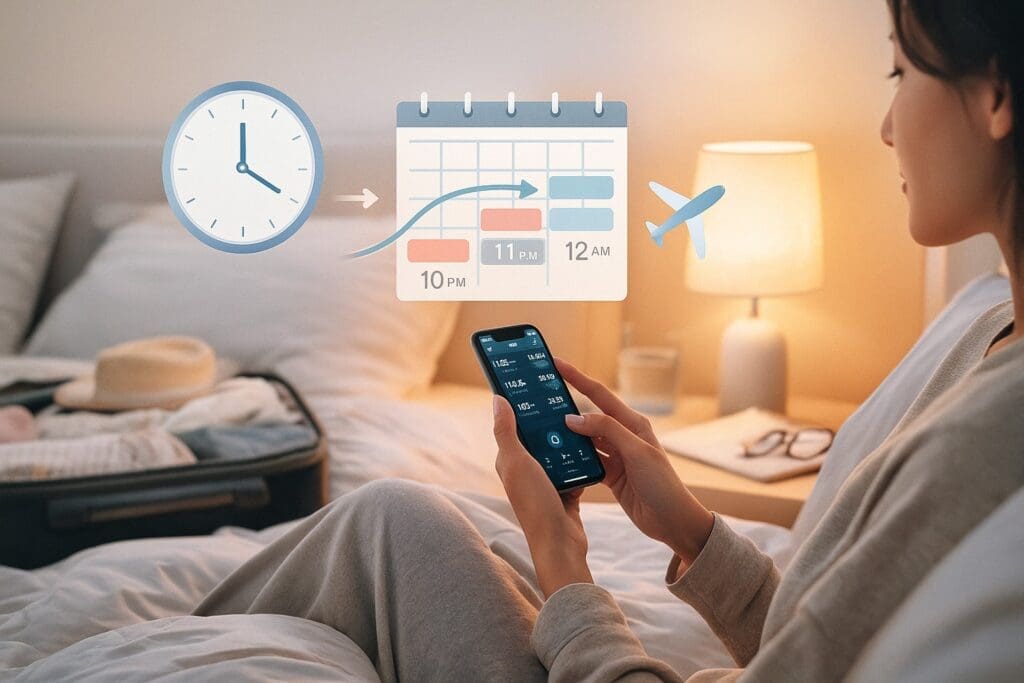Al Riffa Park Ras Al Khaimah: New Green Space Opening Soon
Table of Contents About the Al Riffa Ras Al Khaimah Park ProjectWhat to Expect From Al Riffa Park, Ras Al…

Travelling halfway across the world is fun, but jet lag can dim your enjoyment and make an otherwise delightful trip miserable.

What is jet lag? Jet lag is a disorder characterized by a disruption in the internal body clock or circadian rhythm that occurs when you cross three or more time zones. For example, travelling from New York to visit Ras Al Khaimah, you must cross nine time zones. New York is on UTC-5 (Eastern Standard Time), whereas Ras Al Khaimah is on UTC+4 (Gulf Standard Time), which means a difference of nine hours or nine time zones.
The term jet lag is a combination of “jet,” a reference to airplanes and air travel, and “lag,” which means delay. Therefore, the literal jet lag meaning is the internal body clock delay caused by air travel. Jet lag is associated with air travel because travelling via airplane allows you to traverse multiple time zones rapidly, leading to a more pronounced lag in your internal body clock.
Jet lag is caused by a mismatch between your circadian rhythm and your current time zone, a consequence of rapidly crossing time zones.
Your body has a circadian rhythm or internal body clock that tracks a 24-hour, light-dark cycle that is crucial to regulating your sleep-wake pattern. Naturally, your body clock matches or is aligned to your home’s time zone (the time zone where you live), so you can feel awake in the daytime and sleepy at night.
However, when you travel eastward or westward, you may have to cross one or more time zones. The globe is virtually divided into 24 individual 15º segments by imaginary lines that run from the North Pole to the South Pole. Each segment is equivalent to one time zone, with each time zone roughly one hour apart from adjacent time zones.
When travel necessitates rapidly crossing at least three time zones, it plays havoc with your body’s internal clock. It throws off the alignment between your circadian rhythm and your location’s light-dark cycle. Your internal body clock is pegged to your original time zone, but you’re already in a new time zone. It may be 10:00 p.m. (and dark) where you are, but your body clock insists it’s still only 1:00 p.m. Consequently, you suffer from jet lag and cannot sleep.
Jet lag is essentially a sleep problem. When you are jet lagged, you feel drowsy during the day but are unable to sleep at night. The lack of sleep makes you feel stressed and listless, leading to even more issues, like irritability.
Jet lag symptoms include the following:

You can prepare yourself to minimize jet lag.
Align your internal body clock to your destination time zone before you leave. The U.S. Centers for Disease Control and Prevention recommends:
Do this gradually, adjusting your sleeping schedule one to two hours per day until your sleeping pattern is as closely aligned to your destination time zone as possible.
Note: Adjust your coffee schedule to your target sleep cycle. Do not have coffee or any caffeinated drinks at least four hours before you’re supposed to sleep.
Bright light wakes you up, while darkness induces sleep. In particular, blue light (a significant part of daytime light) signals wakefulness and alertness.
If you’re trying to sleep later than usual because you’re travelling westward:
Use block-out curtains so that the early morning light will not disturb your sleep, and you can wake up later than usual.
If trying to sleep earlier than you’re accustomed to because you’re travelling eastward:
Before boarding the plane, eat only small, light, and easy-to-digest meals. Consider a salad, some fruits (especially bananas), and thin soups.
Avoid greasy and spicy foods, as these may lead to an upset stomach. Do not drink alcohol and coffee.

There are things you can do in-flight to minimize your jet lag symptoms.
Drink lots of water. Flying can cause dehydration, which can worsen jet lag symptoms, and drinking water is key to combating dehydration.
On average, women need about 11.5 cups of water per day, while men require about 15.5 cups. Note, however, that we also get about 20% of our water intake from the food and beverages we consume.
The amount of water we must drink also varies depending on age, gender, height, weight, activity level, climate, and food and beverage consumption. You can consult a nutritionist for a precise calculation of your water intake requirements.
Consume foods and drinks that are rich in tryptophan, an amino acid that supports the production of serotonin and melatonin. Serotonin helps regulate sleep patterns, among its many functions, while melatonin helps maintain your internal body clock. Melatonin-rich foods and drinks are also recommended.
The following are foods rich in tryptophan:
Among the above, eggs, fish, and nuts are also rich in melatonin. Tart cherries and goji berries are also excellent sources of melatonin.
How about beverages? Water is the best drink. Milk is also a good option if you’re not lactose-intolerant, as milk is rich in both tryptophan and melatonin.
Qantas Airlines actually operated research flights to test strategies for minimizing jet lag symptoms. Their initial findings indicate that tailoring the lighting and mealtime schedules to the destination time zone, facilitating simple stretching and movement activities in-flight, and providing a tryptophan-rich menu effectively lead to less severe jet lag, better sleep quality in flight, and faster jet lag recovery.
It depends. Check the time at your destination and use that as your basis. If you ‘re accustomed to sleeping from 10:00 p.m. to 6:00 a.m., and you’re mid-flight when the clock strikes 10:00 p.m. at your destination time zone, sleep on the plane. If it’s daytime at your destination, stay awake.
For better monitoring, change your watch or mobile phone clock to your destination time zone.

Here are tips on how to recover from jet lag faster.
Exposure to sunlight during the day will help you stay alert in the daytime, so try to get as much sun as you can at your destination. If you must stay indoors, use indoor light, particularly LED light, which has more blue light than fluorescent light, to get similar benefits.
Note: There are beachside resorts in Ras Al Khaimah that are ideal for soaking up the morning sun. These include Rixos Al Mairid Ras Al Khaimah, which has a 1.5-kilometer private beach, Mövenpick Resort Al Marjan Island (as well as the other hotels in Al Marjan Island), and Anantara Mina Al Arab.
You should also exercise. Research by Arizona State University professor Shawn Youngstedt and his colleagues indicates that exercise can help push back or advance someone’s circadian rhythm.
Their study also found that exercising between 1:00 and 4:00 a.m. or at 10:00 a.m. has no effect on the body clock.
If you arrive in the daytime, try to hold on and push through without sleeping until it’s time to sleep according to your current time zone’s 24-hour cycle. If you must, you can nap, but be strategic about it.
Take only short naps, no more than 30 minutes each time. More importantly, make sure not to take any more naps at least four hours before your bedtime.
Eat according to the current time zone. If you eat breakfast at 7:00 a.m., do not change your routine, but follow the local time, not your original time zone. That said, stick to the food you’re accustomed to in the first few days to minimize digestion problems.
Typically, recovery from jet lag takes from a few to several days. It depends on various factors, such as the number of time zones you crossed, your pre-departure preparation, and what you did and ate in-flight. If you were able to train your body clock to adapt to your destination time zone before you left home, it may take you no time at all to recover from jet lag.
Jet lag pills and supplements can be effective, but it’s best to consult your doctor before taking them. Melatonin supplements may induce sleepiness, while caffeine supplements may induce wakefulness. In either case, timing is crucial, as melatonin is best taken about 30 minutes before your desired bedtime, while you must avoid caffeine at least six hours before your target sleeping time.
If planning to cross at least three time zones with children, make sure to include them in your time-zone and body-clock-adjustment preparations. Gradually adjust your house’s lighting and your children’s wake-sleep cycles according to your destination time zone. You can also change the time you eat breakfast, lunch, and dinner, slowly changing it so it follows your destination’s meal times.
Table of Contents About the Al Riffa Ras Al Khaimah Park ProjectWhat to Expect From Al Riffa Park, Ras Al…
Table of Contents The 1000 Miglia Experience UAE Route Through Ras Al KhaimahWhat Kind of Classic Cars Participate in the…
Table of Contents AccommodationGastronomyThe Concept Store (Store, Café, Cocktails, Lounge)The Market (Buffet, All-Day Dining)Chiano (À La Carte, Dinner Only, RSVP…
Table of Contents The Role Mangroves Play in Ras Al KhaimahYour Guide to Kayaking in the Mangroves of Ras Al…
Table of Contents 1. Jebel Jais2. Wadi Shawka3. Al Wadi Desert Reserve4. Flamingo Beach5. Ras Al Khaimah’s Mangroves6. Wadi Bih7.…
Table of Contents 1. Desert Escapes and Private Dining Under the Stars2. Spa Suites and Wellness for Two3. Sunset Cruises…